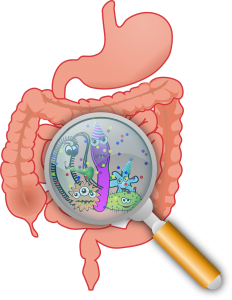
You’ve probably noticed I’ve been spending a lot of time researching and studying one of my favorite topics, essential oils! I am always excited and compelled to share on these plant secondary metabolites! This is because they are an easily accessible, versatile, integrative, and empowering health tool with so many beneficial effects.
However, many of you may remember, I do have another favorite topic…
If you haven’t guessed it, I’m talking about the belly (and other) bugs that line our insides and outsides. I felt like this week was a good time to revisit and honor everyone’s trillion tiny friends that have a powerful impact on our wellness! I don’t want them to feel under-appreciated, after all. ?
The intriguing influence of these critters directly, through communicating with our cells, and their altering genetic expression has caused the microbiome to be one of the hottest topics in medicine, not just my obsession.
Clinicians and researchers alike have been awed by since the Human Microbiome Project’s (HMP) first wave of results from 2007-2012. It was then that many scientists realized they may have gotten more questions than answers. We had opened a large, positively-spun Pandora’s box!
Today, we are continuing to learn the complexities of this “new organ system” and its intricacies on all aspects of one’s health!
Below are some the most interesting and latest findings of the microbiome from February 2017 headlines. You can also find some more updates on the Top Holistic and Integrative Health Reads on my homepage here. If you still want more, you can go to the National Institutes of Health (NIH) Common Fund website on the Human Microbiome Project (HMP).
Headlines That Won’t Bug You
Analyzing Gut Bugs’ Byproducts from Antibiotics- The Impact On Rats and Human Health
There has been a lot attention on “who” inhabits our gut and how these buggy populations are associated with health conditions. Other scientists now feel we need to study more specific impacts, such as how they can shift and modulate the “metabolome” (the sum of the body’s primary and secondary metabolites).
In a recent rodent study in mSphere, researchers sought to do the latter. First, they demonstrated how different bacteria in rodent poop were altered in various ways by antibiotics. Science Daily states:
Antibiotic treatment resulted in significant shifts of microbial composition and structure within 14 days of antibiotic treatment, the researchers noted. Ciprofloxacin resulted in a significant decrease of several types of bacteria, including Streptococcus, Lactobacillus and Clostridium, as well as an increase in Bacteroides and other species. Some families were completely depleted by the antibiotics. Vancomycin-imipenem treatment also resulted in significant differences, including reductions in members of the Bacteroides and Firmicutes phyla, and increases in the relative abundance of Proteobacteria.
The researchers then also looked at how the fecal microbiota (in rat poo) shifted nine days post- treatment. Finally, it was determined that the different antibiotics altered amino acid (protein building blocks) metabolites after the microbial shifts occurred.
The impact on human health by these alterations was considered to be very important…
Many of the bacterial populations that changed following antibiotic exposure contribute to human health, Rogers said. “For example, the Ruminococcaceae family, which was substantially reduced, produces important short-chain fatty acids by fermenting carbohydrates that humans cannot absorb themselves. These acids contribute to many aspects of our health, including epithelial cell turnover, which reduces the risk of colon cancer; gut barrier function, which prevents bacteria from getting into the bloodstream; and regulation of immune and metabolic controls. Antibiotic exposure also increased levels of the Enterobacter genus of bacteria, many species of which cause disease.”
Therefore, it’s not only important to study what belly bugs we have and what health conditions they are associated with, but also how they change, what populations or species predominant, and what the impact on the metabolome is based on different triggers, such as antibiotics.
Complicated, right?!
Mining the Human Gut Microbiota for Immunomodulatory Organisms
Your next prescription could be all “bugged out.”
According to Science Daily, researchers are assessing the communication between specific critters and immune system responses. In other words, they are eavesdropping on the phone calls between our bugs, our genes, and our immune cells’ reactions. The hope is that more specific targets for treating immune system disorders will result. The article states how the authors found evidence of altering genetic expression of the host resulting in changes in the bugs’ living environment:
“We believe that some microbes may upregulate certain genes to create a more hospitable environment for themselves, while others may downregulate certain ones to create a more hostile one for harmful bacteria,” Kasper said. When researchers analyzed bacterial effects on genes that regulate the activity of cytokines — signaling molecules responsible for inducing inflammation in response to infection, cancer and other diseases — they once again observed the same balancing dynamic at play: Some bacteria boosted the activity of these genes while others turned it down.
There was also a surprise: there was a redundancy in function of differing microbes. It wasn’t just that certain bugs did a specific action, various critters could take on roles depending on what the environment was and who was present:
Also, contrary to expectations, the researchers said, bacteria that belonged to the same class did not necessarily have the same, or even similar, effects on immune cells. That observation, researchers say, suggests an evolutionary fail-safe mechanism to ensure the preservation of key immune functions even if whole classes of bacteria are lost.
(Journal reference)
Interesting that these findings are related to the first article discussed. It wasn’t just a function of “these bugs have these effects,” rather, “these bugs can do these things in this specific environment they influence.”
More complications!!
In another related study on this connection, it was shown that microbes in mice can modulate insulin secretion and be effected by genetics and diet. (Journal)
Gut Bugs Ups and Downs and IBD
According to Science Daily:
Patients with inflammatory bowel disease are more likely to see dramatic shifts in the make-up of the community of microbes in their gut than healthy people, according to the results of a new study. The results help physicians and scientists understand the disease more fully and potentially offer new ways to track the disease and monitor patients.
In a related study, it was found that the inflammatory changes mediated the environment and altered the bacteria that preferred to “take residence” in this more inflamed location. (Journal)
This again supports the theme above of the nature of the bug population and the nurture effect of the environment “feed into” each other!
More sources:
Pacific Northwest National Laboratory
Journal Reference
Phew, now that you are caught up here, make sure to catch up more here.
Stay tuned for some upcoming info on my homepage on how to love these buggies more.



